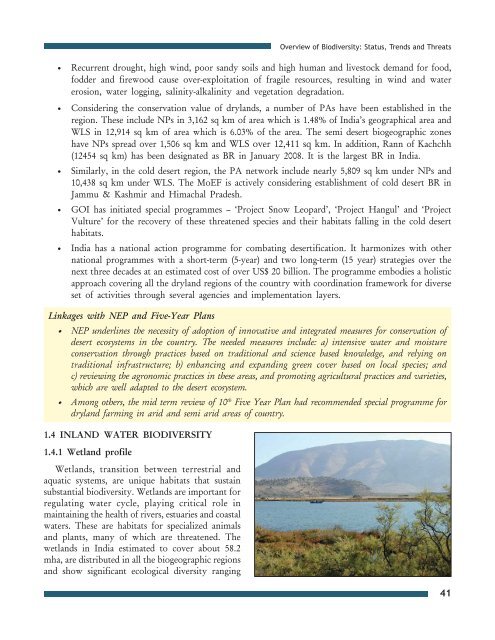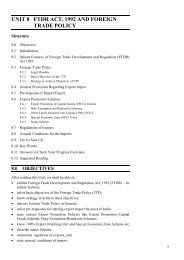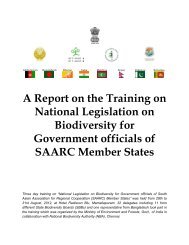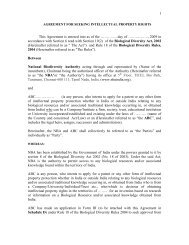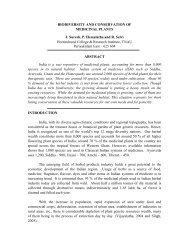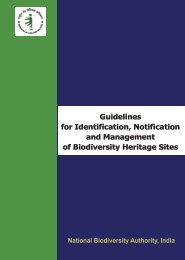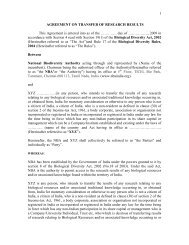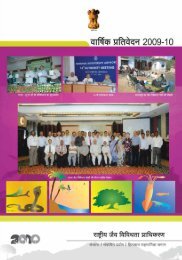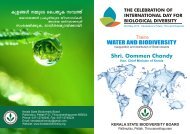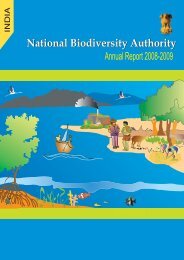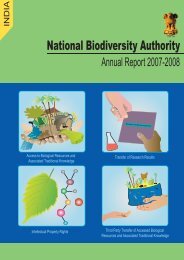Part 1 - English version (PDF) - Convention on Biological Diversity
Part 1 - English version (PDF) - Convention on Biological Diversity
Part 1 - English version (PDF) - Convention on Biological Diversity
Create successful ePaper yourself
Turn your PDF publications into a flip-book with our unique Google optimized e-Paper software.
Overview of Biodiversity: Status, Trends and Threats<br />
<br />
<br />
<br />
<br />
<br />
Recurrent drought, high wind, poor sandy soils and high human and livestock demand for food,<br />
fodder and firewood cause over-exploitati<strong>on</strong> of fragile resources, resulting in wind and water<br />
erosi<strong>on</strong>, water logging, salinity-alkalinity and vegetati<strong>on</strong> degradati<strong>on</strong>.<br />
C<strong>on</strong>sidering the c<strong>on</strong>servati<strong>on</strong> value of drylands, a number of PAs have been established in the<br />
regi<strong>on</strong>. These include NPs in 3,162 sq km of area which is 1.48% of India’s geographical area and<br />
WLS in 12,914 sq km of area which is 6.03% of the area. The semi desert biogeographic z<strong>on</strong>es<br />
have NPs spread over 1,506 sq km and WLS over 12,411 sq km. In additi<strong>on</strong>, Rann of Kachchh<br />
(12454 sq km) has been designated as BR in January 2008. It is the largest BR in India.<br />
Similarly, in the cold desert regi<strong>on</strong>, the PA network include nearly 5,809 sq km under NPs and<br />
10,438 sq km under WLS. The MoEF is actively c<strong>on</strong>sidering establishment of cold desert BR in<br />
Jammu & Kashmir and Himachal Pradesh.<br />
GOI has initiated special programmes – ‘Project Snow Leopard’, ‘Project Hangul’ and ‘Project<br />
Vulture’ for the recovery of these threatened species and their habitats falling in the cold desert<br />
habitats.<br />
India has a nati<strong>on</strong>al acti<strong>on</strong> programme for combating desertificati<strong>on</strong>. It harm<strong>on</strong>izes with other<br />
nati<strong>on</strong>al programmes with a short-term (5-year) and two l<strong>on</strong>g-term (15 year) strategies over the<br />
next three decades at an estimated cost of over US$ 20 billi<strong>on</strong>. The programme embodies a holistic<br />
approach covering all the dryland regi<strong>on</strong>s of the country with coordinati<strong>on</strong> framework for diverse<br />
set of activities through several agencies and implementati<strong>on</strong> layers.<br />
Linkages with NEP and Five-Year Plans<br />
NEP underlines the necessity of adopti<strong>on</strong> of innovative and integrated measures for c<strong>on</strong>servati<strong>on</strong> of<br />
desert ecosystems in the country. The needed measures include: a) intensive water and moisture<br />
c<strong>on</strong>servati<strong>on</strong> through practices based <strong>on</strong> traditi<strong>on</strong>al and science based knowledge, and relying <strong>on</strong><br />
traditi<strong>on</strong>al infrastructure; b) enhancing and expanding green cover based <strong>on</strong> local species; and<br />
c) reviewing the agr<strong>on</strong>omic practices in these areas, and promoting agricultural practices and varieties,<br />
which are well adapted to the desert ecosystem.<br />
Am<strong>on</strong>g others, the mid term review of 10 th Five Year Plan had recommended special programme for<br />
dryland farming in arid and semi arid areas of country.<br />
1.4 INLAND WATER BIODIVERSITY<br />
1.4.1 Wetland profile<br />
Wetlands, transiti<strong>on</strong> between terrestrial and<br />
aquatic systems, are unique habitats that sustain<br />
substantial biodiversity. Wetlands are important for<br />
regulating water cycle, playing critical role in<br />
maintaining the health of rivers, estuaries and coastal<br />
waters. These are habitats for specialized animals<br />
and plants, many of which are threatened. The<br />
wetlands in India estimated to cover about 58.2<br />
mha, are distributed in all the biogeographic regi<strong>on</strong>s<br />
and show significant ecological diversity ranging<br />
41


